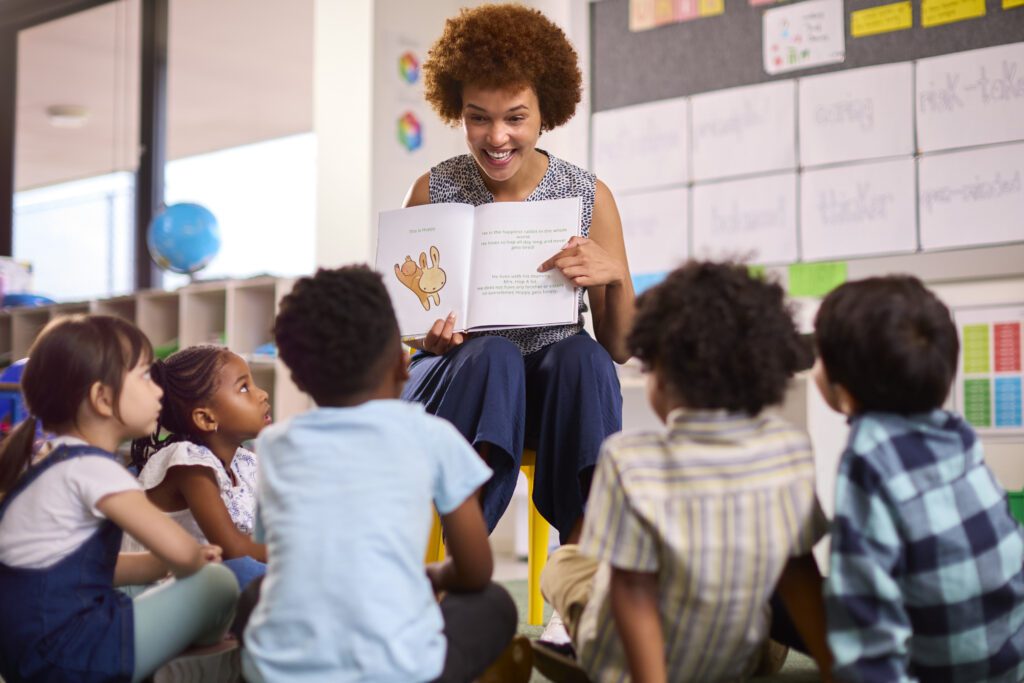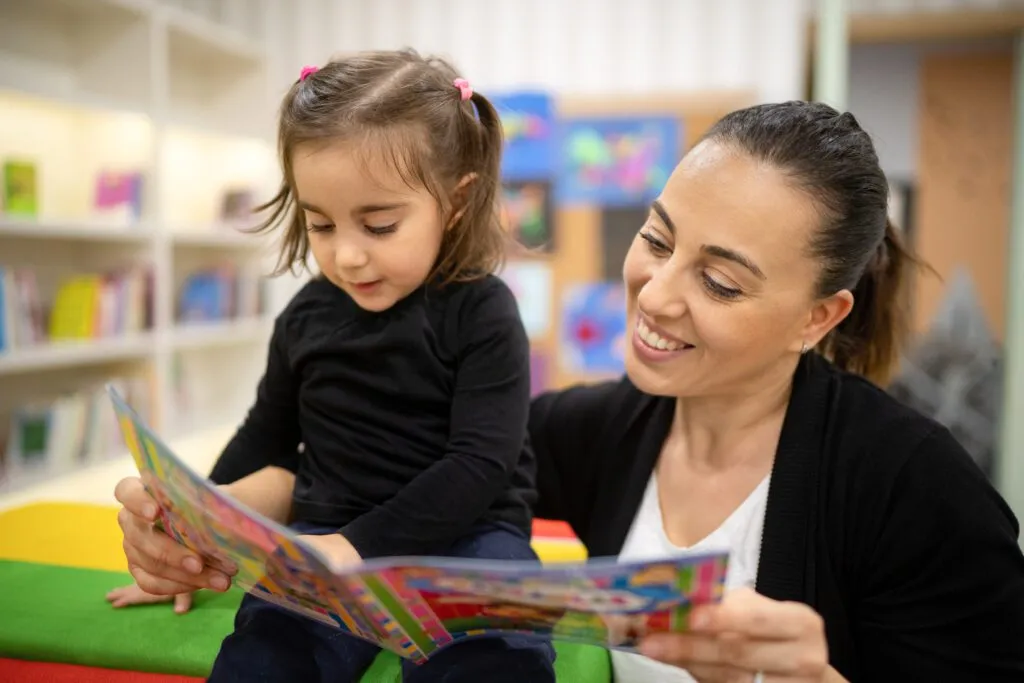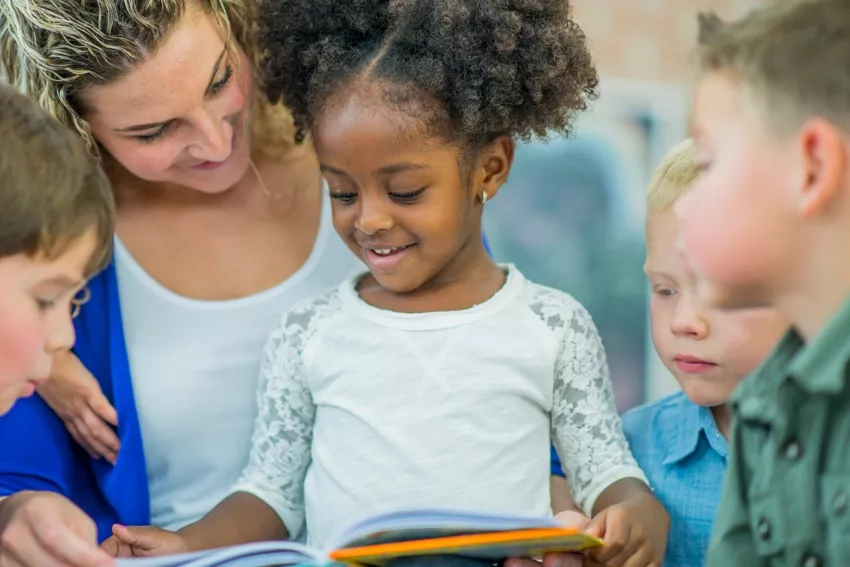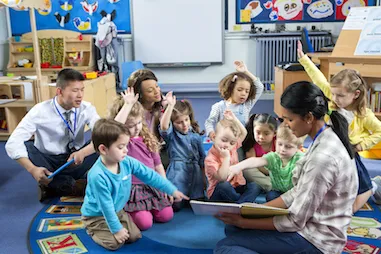7 Strategies for Incorporating High-Quality Pre-K Books Into Your Classroom

Children develop a love of reading long before they are readers themselves, and early childhood teachers play a central role in nurturing the skills and attitudes that will help children become readers who are both capable and driven. When children come to know reading as a pleasurable experience, they are more likely to choose to do it. And the more they read, the better they get at it. It’s a beautiful cycle!
Here at Teaching Strategies, we recommend that pre-K teachers read aloud to children many times throughout the day for a variety of purposes, exposing them to different kinds of print materials, including fiction, nonfiction, and poetry. For example, if your purpose is to help them follow the steps to a process, you may read directions from a poster or sign. If your purpose is to help children find answers to their questions related to your current study topic, you’ll want to reference related nonfiction titles. If your purpose is to help children develop phonemic awareness, you may turn to a book of nursery rhymes, fun poems, or tongue twisters.
But if your purpose is to help children develop a love of reading, make meaningful connections to characters, or understand how to solve social problems, you will want to choose high-quality children’s literature with more complex storylines.
Why Not Stick With Simple Stories, Simple Plots, and Simple Characters?
It’s understandable why some teachers shy away from pre-K books with complex storylines. They are often longer than other options available for children, and they are certainly more involved. They typically include at least a few words that may be unfamiliar to children, and they are often far more nuanced in the messages they deliver.
But these are actually all reasons that you should be reading these kinds of books to children. There is a direct connection between the quality of children’s experiences with literature—and the quality of their reactions to books and their understanding of the people, places, and problems within—and the quality of the material being read to them.
Rich storylines lead to rich experiences. Here are seven strategies for helping children in pre-K enjoy and benefit from children’s literature with complex storylines and compelling characters.
- Choose high-quality pre-K books.
When selecting pre-K books to share, you can consult lists of award-winning books, ask families and colleagues for ideas, and take a look at book reviews posted in sources you trust. Also, don’t forget to talk to your local children’s librarians, who are fonts of knowledge about the best children’s books, from the oldest classics to the newest releases. - Pre-read your books.
Once you’ve selected a few titles that look good to you, read through them and ask yourself if there’s anything here that would be interesting to talk about with a group of four-year-olds. Did anything make you laugh? Feel teary? Cause you to wonder? Pay attention to these things, because big feelings and deep wonder are two revealing benchmarks when it comes to selecting children’s literature that’s worth children’s (and your) time. - Divide the book into multiple readings.
As adults, we seldom read a book from cover to cover in one sitting. Children don’t need to, either. Follow their lead as you gauge their interest. Reading only a few pages at a time gives children time to think about what’s happened so far and helps build anticipation for what’s coming next. It also offers them the opportunity to recall events before you jump back in. - Talk about the book as you read it.
Use open-ended questions to discuss what’s going on, how the children feel about it, what they think of each of the main characters, and whether they’d react the same or differently if they were in a similar situation. - Pay attention to the illustrations.
Many of the best children’s books are beautifully illustrated. Talk to children about what’s going on in the pictures and how the words and pictures work together to tell the story. - Vary the audience size.
Of course, you can read aloud to your entire class in a large-group setting, but consider also reading to small groups of children. A smaller audience means you are better positioned to interact with each child, watch their reactions, and invite their comments and questions. - Reread and reread again!
The best books deserve to be reread. Each time you revisit a story, children are able to strengthen their understanding of new vocabulary introduced by the narration or dig deeper into characters’ motivations. Pay attention to how much children remember and how they engage with the story differently the second (or even third!) time around.
While books with complex storylines may at first seem intimidating, I believe firmly that once you engage children in pre-K with compelling characters solving puzzling problems, you’ll never again not want to share these kinds of books with them. Complex stories not only makes reading more meaningful for children, but the positive connections they forge with the characters and their feelings serve only to deepen the positive connections they forge with you. As I said earlier, it’s a beautiful cycle!

Instill a Love for Reading in Pre-K
Prepare children for reading proficient in third grade, and instill a love for books and reading now, with The Creative Curriculum for Pre-K.
Learn More


